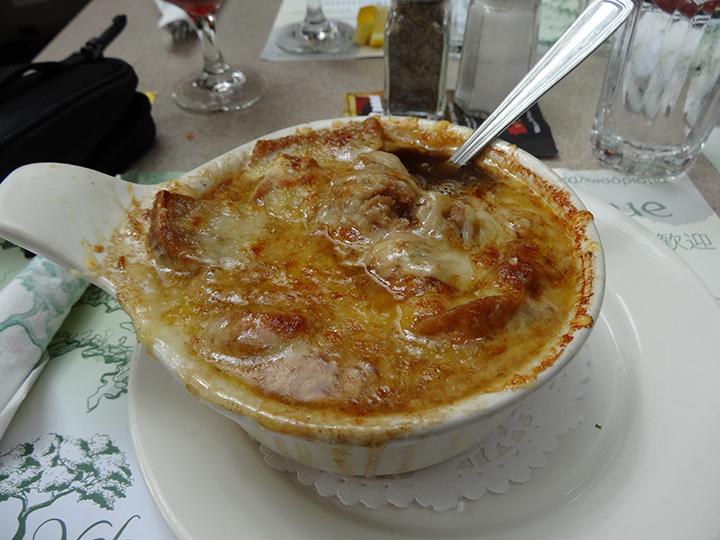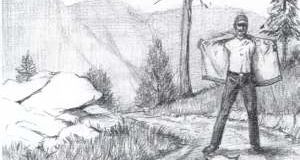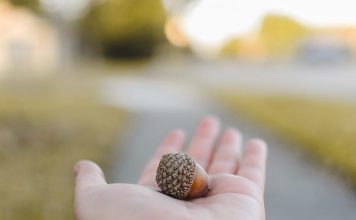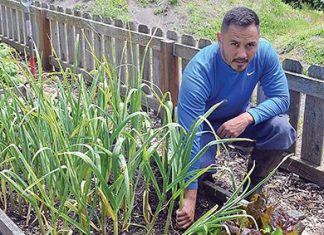Recipe of the Week
French Onion Soup
& Julia Child’s Beef Stock
Courtesy of
Richard Blunt
INGREDIENTS
4 Tbsp light olive oil
8 cups thinly sliced onions
1/2 tsp granulated sugar
1 level Tbsp flour
2 1/2 qts your best home made beef stock
4 Tbsp good brandy
Note: Homemade beef and chicken stocks, when made properly, do not contain flavor enhancers like salt and pepper. This important feature makes homemade stock more versatile in many different recipes, and absolutely essential in this one. (See below for Bonus recipe – Julia Child’s Beef Stock)
METHOD
1. Set a heavy bottom sauce pan over medium heat and add the oil. When the oil is hot, add the onions. Cover the pan and cook the onions slowly until they are tender and translucent. This will take about ten minutes.
2. Remove the lid, raise the heat to medium high, and stir in the sugar. Continue to cook the onions, stirring frequently, until they take on a dark walnut brown color. This will take about 20 to 25 minutes.
3. Sprinkle in the flour and continue to cook the onions while stirring for an additional 2 minutes.
4. Remove the onions from the heat and set them aside (without removing them from the pot) to cool a little.
5 While the onions are cooling, heat the stock to a slow simmer. Stir about 3 cups of hot stock into the onions along with the brandy. Return this mixture to the stove over medium high heat and bring it to a simmer. Cook this mixture while gently stirring for about 3 minutes.
6. Add the remaining stock, loosely cover the pot, and slowly simmer the soup for about one and a half hours.
7. Adjust seasoning with salt and freshly ground black pepper before serving
Julia Child’s Beef Stock
INGREDIENTS
4 pounds beef bones (cut into 3 inch pieces)
2 each large carrots, onions, and celery ribs (roughly chopped)
7 quarts cold water (if you have lousy tap water, buy bottled)
3 large cloves fresh garlic (Smashed or as Julia would say,” WHAM, “)
1/2 cup canned Italian plum tomato (roughly chopped)
1 each herb bouquet
Tie, in a piece of cheese cloth, 4 allspice berries, 6 black peppercorns, 1/2 tsp dried thyme, 1 small bay leaf, and 4 sprigs of fresh parsley (roughly chopped)
METHOD
1. Preheat your oven to 450 degrees. Arange the bones and 1/2 cup of each vegetable in a large roasting pan to form a single layer. Roast this mixture, turning frequently, until the bones turn a walnut brown. Transfer the roasted bones and vegetables to a suitable size stock pot.
2. Discard the fat and then de-glaze the pan. To do this: set the pan on the large burner on the stove top, add 2 cups of water to the pan, bring the mixture to a boil over medium high heat. Use a wooden spoon to scrape the bottom of the pan. Add the pan juices to the bones and the vegetables in the pot.
3. Add the herb bouquet and the rest of the vegetables to the pot along with enough water to cover the ingredients by at least two inches. Bring this mixture to a simmer on top of the stove. Initially there will be a grayish scum that will rise to the top of the pot. Keep alert for this and continuously scoop it out until it no longer appears.
4. Loosly cover the pot. Continue to cook the stock at a constant slow simmer for at least 4 hours. Skim off any fat that forms on top and add a little boiling water from time to time, especially if you notice that the stock level in the pot has dropped.
5. Strain the stock through a colander into large bowl and carefully remove any grease that rises to the surface. Strain the stock again. This time, line the colander with a double layer of cheese cloth.
6. Pour the stock into a clean roasting pan and allow it to cool at room temperature. This step must be complete in less then 2 hours to prevent the growth of spoilage bacteria.
7. Transfer the cooled stock into suitable size container and refrigerate or freeze.















Wow, brings back memories! I remember watching that exact show and thinking the same thing! Searching for the recipe from that show brought me here. Thanks for a great story!
Thank you so much Richard Blunt for your delivery of these two incredibly delicious recipes.Your manner of speach has guided me with enthusiasm today.Im on the way to the market to purchase needed ingredients.Also you taught me two new methods I had been unaware of.